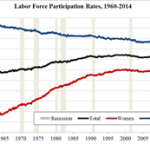 The Social Security Advisory Board has appointed members of a Technical Panel to examine future trends in labor supply, a key factor in projections of revenues and expenditures of the Social Security programs. Robert A. Moffitt, Krieger-Eisenhower Professor of Economics at Johns Hopkins University and former editor of the American Economic Review, will chair the panel. Members will include: Gary Burtless, John C. and Nancy D. Whitehead Senior Fellow at the Brookings Institution; Chinhui Juhn, Henry Graham Professor of Economics at the University of Houston; Kevin M. Murphy, George J. Stigler Distinguished Service Professor of Economics in the Department of Economics and Graduate School of Business, University of Chicago, and Winner of a MacArthur Prize and the John Bates Clark Medal; and Kathleen McGarry, Professor of Economics at UCLA.
The Social Security Advisory Board has appointed members of a Technical Panel to examine future trends in labor supply, a key factor in projections of revenues and expenditures of the Social Security programs. Robert A. Moffitt, Krieger-Eisenhower Professor of Economics at Johns Hopkins University and former editor of the American Economic Review, will chair the panel. Members will include: Gary Burtless, John C. and Nancy D. Whitehead Senior Fellow at the Brookings Institution; Chinhui Juhn, Henry Graham Professor of Economics at the University of Houston; Kevin M. Murphy, George J. Stigler Distinguished Service Professor of Economics in the Department of Economics and Graduate School of Business, University of Chicago, and Winner of a MacArthur Prize and the John Bates Clark Medal; and Kathleen McGarry, Professor of Economics at UCLA.
Many of the forces affecting labor supply trends have been in effect for many decades and are well-understood. Others reflect emerging trends in the globalization of markets, technology, demographics and the disruption caused by the recent financial crisis and subsequent Great Recession.
Previous Technical Panels appointed by the Board and tasked to look at the full range of assumptions and methods used in the long-range projections of Social Security finances have noted the complexity of the labor force projection methodology and the need to adequately account for the turbulent forces shaping our current and future U.S. labor market. Many questions require further investigation:
- Will the upward trend in female labor force participation, which has virtually stopped growing in recent years, resume?
- Will the decades-old decline in labor force participation of prime age males continue?
- Will the growth of labor force participation of older age groups (55+) from the late 1980s until the early 2000s resume?
- Will the decline in labor force participation associated with the Great Recession prove to be temporary or permanent?
- Will the decline in cohort size associated with comparatively modest birth rates of recent years cause employers to undertake measures to induce more older workers to remain in the labor force?
- How will the currently assumed composition of future immigrants affect labor force participation rates?
- Do the current methods of projecting labor force participation adequately account for the factors most likely to affect trends in the future?
To deal adequately with the underlying complexity and the shifting economic and demographic landscape, the Board believes that a closer and more sustained look specifically at this element of the overall financial projections by an independent panel of experts is warranted. Such a Panel would consult closely with representatives of the Chief Actuary’s office to fully understand the current methodology. They would confer with representatives of other government agencies who are required to make similar projections, such as the Bureau of Labor Statistics, the Council of Economic Advisers, the Congressional Budget Office. They would review the relevant recommendations of past Technical Panels and confer with other independent experts as the Panel deems necessary in person or in writing. The panel would be asked to prepare a report that would reflect any consensus views of the members. On methods or findings where consensus does not emerge, the report should present competing views with complete and detailed explanations of the sources of disagreement.
CHARTER: The Panel will evaluate the assumptions used by the Trustees and the methods employed by the Office of the Chief Actuary to project the size of the labor force and rates of labor force participation and will make recommendations on how best to improve those assumptions and methods. The Panel members will meet in public at least three times and deliver a written report to the Board with their recommendations within 7 months of their first meeting.
Additional information on previous Technical Panels appointed by the Social Security Advisory Board to review all the assumptions and methods used in the Trustees annual Projections of Social Security long-range finances can be found here.